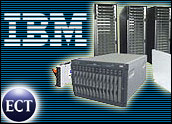
IBM said today that its bet on blade server technology is paying off, announcing that more than 100 companies had acquired its eServer BladeCenter specification since the blade server base technology was made available last September.
IBM, which opened its BladeCenter design specification with Intel, called the rapidly growing support evidence that blade servers are moving beyond their traditional role in IT infrastructure, broadening in both hardware support and market share.
Analysts agreed that blade servers — typically smaller, slim form-factor devices for networking, storage, and other functions that are used together in large numbers — are replacing larger, more complex devices and growing rapidly in market share.
“The trend is huge,” IBM director of eServer BladeCenter marketing Tim Dougherty told TechNewsWorld. “It’s the fastest growing server in IBM’s history, so it’s beyond just another form factor.”
Cutting into the Stack
IBM claimed that its open spec strategy, intended to foster innovation from third-party hardware vendors, has been a success. The company recently opened the Power microprocessor for the same reasons. Research from IDC projects one in every four servers will be a blade by 2007.
Yankee Group senior analyst Zeus Kerravala said that although it may take some time, it is likely that blade servers will eventually replace all parts of the software stack because of their time-to-market, cost and scalability advantages.
“I don’t think blades are enough to make people rip out what they have and replace it,” Kerravala told TechNewsWorld. “I think they’ll stack along server adoption. It will be like the move from the mainframe to the PC. It’ll happen gradually, but I have no doubt in my mind that just about everything will be run on a blade [eventually].”
Benefits in Bulk
IBM’s Dougherty said prior to opening the BladeCenter specification with Intel this fall, IBM was forced to engage blade hardware supporters on a one-on-one basis. While the company had partnerships with networking and other vendors such as Brocade, Cisco, Nortel and others, it became clear that for wider support, the specification had to be available to more companies, Dougherty said.
He added the BladeCenter install base was also calling for an open specification that would allow more customization and specialization.
With the BladeCenter hardware support announced this week — which includes development companies such as Emulex, Ranch Networks and Tarari — IBM said it hoped to maintain its dominant position in blades. The company now claims nearly 47 percent of global revenue from the devices, according to research firm Gartner.
Paradigm Shift
Dougherty, who highlighted that venture capitalists are among Big Blue’s blade strategy supporters, said the growth of blade server use was being driven by a change in the IT paradigm from the larger, central storage of applications to the assembly of smaller, application-specific blades.
“This is really about the value of integrating,” Dougherty said. “Instead of the silo approach, you have blades for storage, for networking and compute. It’s all coming back together.”
Dougherty added the transition is most apparent with security and other so-called IT appliances, where blades make more sense mainly because of efficiency and scalability.
Yankee Group’s Kerravala praised IBM’s strategy and said that by opening the BladeCenter specification, the company was looking to boost the software and services that run on blades.
He also indicated that blade servers have moved beyond their original role of high-density, high-performance servers to be used as network, security and other software components.
“The value is the software, and IBM is promoting that,” Kerravala said. “When third-party companies are building applications to go on top [of the blade server], that’s when you’ll see it take off.”






















































Put 5 blade centers in a 42 u rack. If they are all fully loaded with blades peak power is 20KW in a 2 foot by 3 foot(approx) foot print. Put 10 of them in a small space.
How you going to keep it cool?